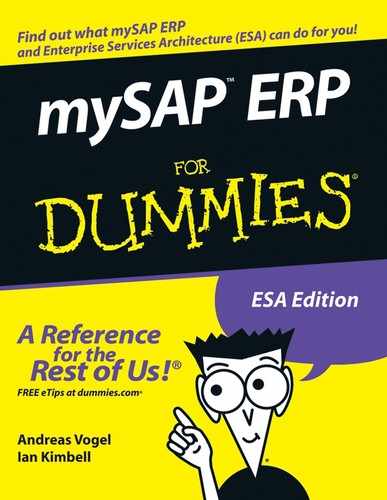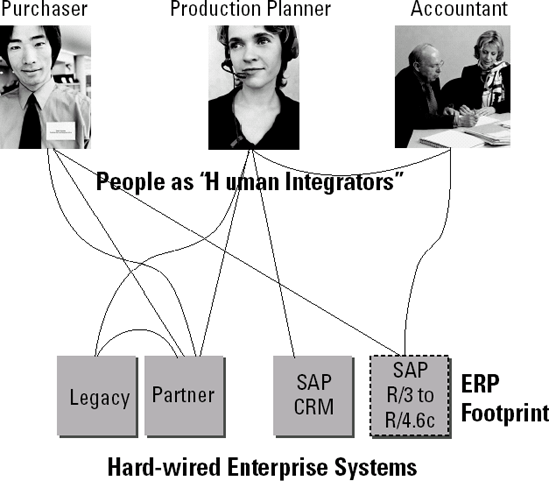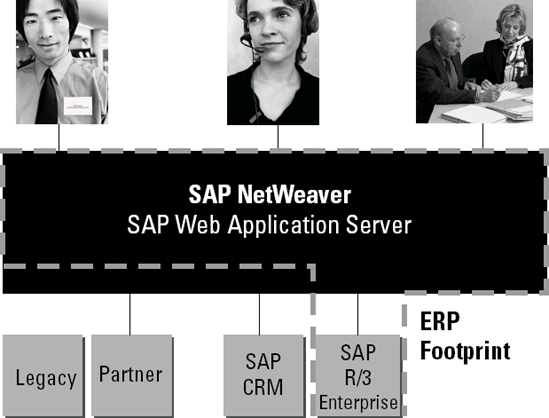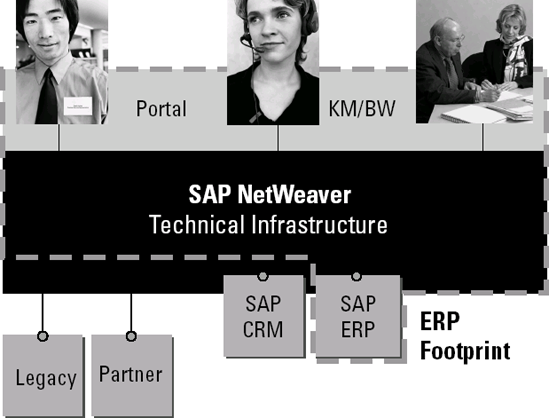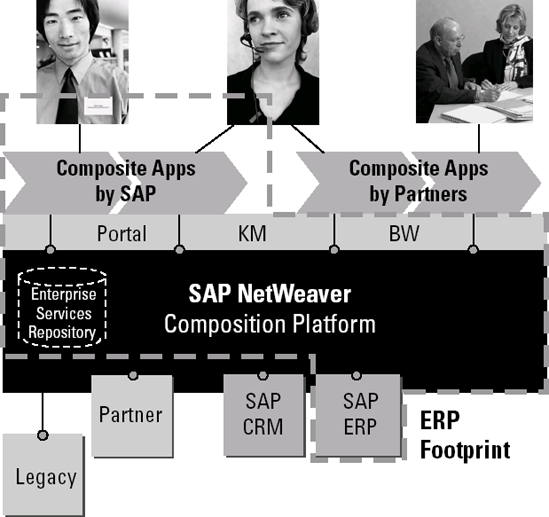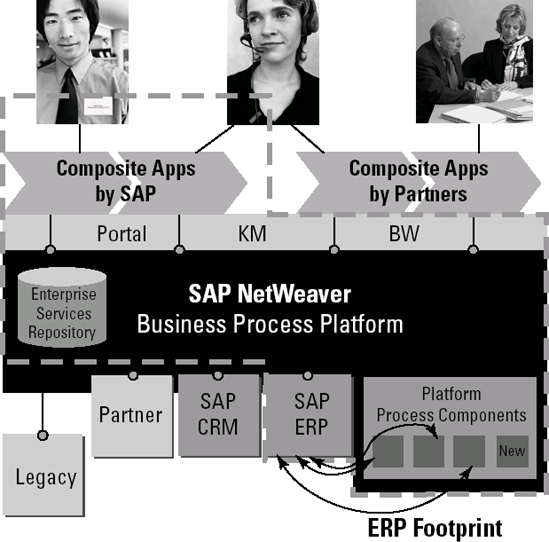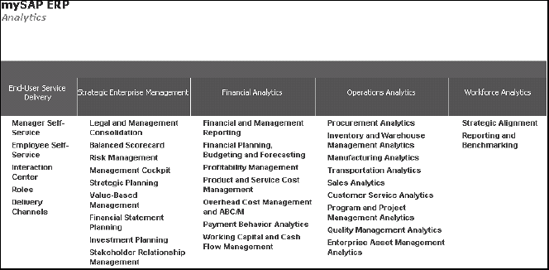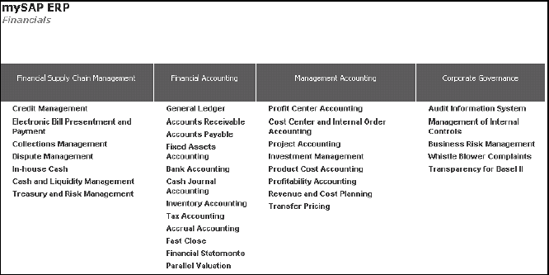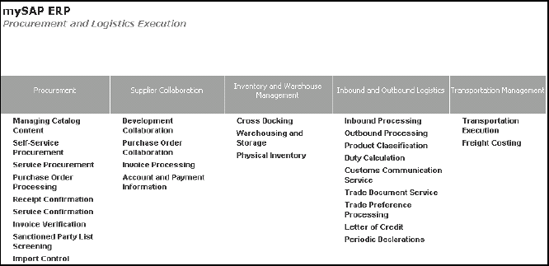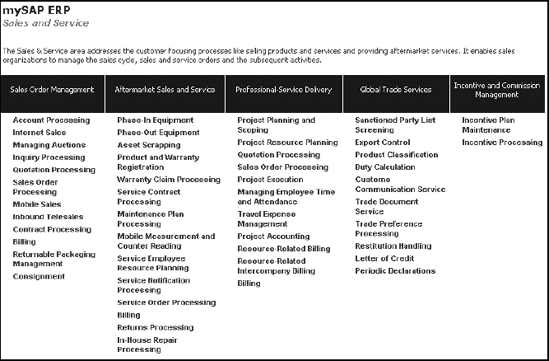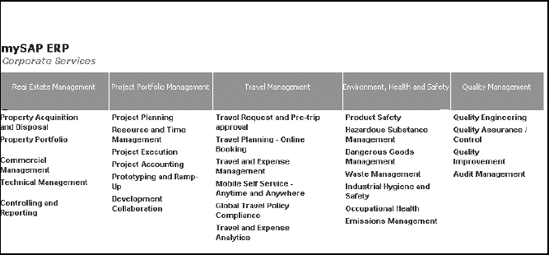More than 20 years ago, enterprise resource planning software started to play a significant role in helping IT executives to cut costs and increase efficiency. These earlier solutions included standard financial, human capital management (HCM) or human resources, and basic operational (order entry, materials management) features. These early off-the-shelf ERP applications enabled IT organizations to reduce application backlogs and implement standard business processes.
Today, however, companies are faced with a very different world. They have less time to get it right and more pressure to do so. Today, innovation occurs with stunning speed, even as the window of opportunity for capitalizing on innovation seems to get smaller every day.
In 2004, SAP launched its next-generation ERP solution, mySAP ERP 2004, which was followed a year later by mySAP ERP 2005. mySAP ERP is an evolution from the traditional ERP solution. It not only allows companies to become more efficient, but it also allows companies to react faster to business change.
But mySAP ERP was just the first step toward a whole new direction for ERP. So where are mySAP ERP and ESA headed in the future? In this chapter, we look into our (informed) crystal ball.
As we discuss throughout this book, Enterprise Services Architecture (ESA) is SAP's open architecture where technology is turned into business processes using enterprise services. This is all done using Web services as building blocks to automate enterprise-wide business scenarios. ESA is central to the future direction of mySAP ERP.
The ESA Roadmap, recently published by SAP, helps you to benefit from a modern service-oriented architecture that allows high flexibility while keeping down the cost of change.
In a nutshell, here's where the road ahead leads: Future development will further integrate SAP NetWeaver technology with the applications, specifically mySAP ERP, leading to the creation of the Business Process Platform (BPP). Applications will be based on ESA and provide enterprise services.
Specifically, the current roadmap for current and future versions of mySAP ERP is as follows:
2005: SAP delivered an inventory of enterprise services, including the first service-enabled scenarios focused on collaboration, end-user needs, and business process flexibility. Customers buying mySAP ERP 2005 can make use of the SAP ESA Adoption Program, take the first steps in their own ESA Roadmap to make the transition to ESA, build business process composition skills, design their own enterprise services, and get experience with service-oriented architecture.
2006: SAP will provide an extended ESA inventory with hundreds of ERP enterprise services, which are implemented and delivered on top of mySAP ERP 2004 and mySAP ERP 2005. You'll also be able to execute major blocks of the ESA Roadmap by extending the ESA Inventory with your own enterprise services. Additional content (new roles and analytics functionality) may also be made available during the year.
2007: Here's where you'll be able to more fully benefit from ESA and reach new levels of differentiating yourself by composing custom processes, as well as using new composite applications.
These future developments are geared to bring more flexibility and reduce the cost of ownership for mySAP ERP. Plans are underway to make technical implementation and maintenance much easier, organizing the process of planning things like how many servers are needed, and setting the stage for easier upgrading down the road. In addition, these future releases offer some really cool tools such as Adobe for Printing and more guided procedures to help users make their own way through business processes.
Future mySAP ERP releases will provide more functions for specific industries. Up until now, the industry solutions were shipped in various ways. Some were shipped with mySAP ERP; others were add-ons that were shipped up to six months later. Starting with mySAP ERP 2005, almost all the industry solutions are shipped together with the ERP software. You can activate the appropriate industry solution using new technology called the switch framework. The switch framework essentially allows you to switch on the industry functionality you want instantly.
Table 12-1 outlines SAP's guiding principles for future developments in mySAP ERP.
Table 12-1. Guiding Development Principles for mySAP ERP
For the next three years, mySAP ERP will continue to build on SAP NetWeaver, working toward the creation of the BPP. But before we head off into tomorrow, we'll try to figure out where we're going by looking backward for a moment.
The traditional footprint of SAP R/3 (up to release SAP R/3 4.6c) was a stand-alone system, where employees mostly acted as the integrators in business processes, running around gathering what they needed to get their work done with different systems, as shown in Figure 12-1.
With the introduction of SAP R/3 Enterprise, the technology layer of SAP R/3 made use of much of the SAP NetWeaver Application Server (SAP NetWeaver AS) for the first time (see Figure 12-2). This made the system a bit more efficient.
The SAP NetWeaver AS formed the new technology foundation for all SAP applications, which didn't just use the SAP NetWeaver AS, but were actually built on it. Also, mySAP ERP from 2004 forward makes extensive use of other SAP NetWeaver components, such as the SAP NetWeaver Portal and the SAP Business Information Warehouse (SAP BW), to offer role-based access and integrated analytics.
In future releases of mySAP ERP, the further integration of SAP NetWeaver is as sure as ants at a picnic. Analytics will play a bigger role to ensure that all the information in a company is available to everybody who needs it. Tighter integration with portals will offer a much better user experience as role-based information is actively pushed to the user (see Figure 12-3).
mySAP ERP 2004 was also one of the first solutions within SAP to make use of composites, where you can quickly build and maintain flexible applications on top of your existing infrastructure. Composites will be a major development focus of future mySAP ERP releases. Already in mySAP ERP, processes such as Create Product, Change Product, or New Employee Hire act as composite processes. In mySAP ERP 2005, more composites were introduced, such as Guided Procedures in self-service applications. All of these use SAP NetWeaver as the underlying technology.
Additionally, partners can make use of the infrastructure to create and develop their own composites, and organizations can leverage both SAP and partner composites to create their own individual applications (see Figure 12-4).
Future development of mySAP ERP will further embrace Web services as a foundation of Enterprise Services Architecture. A repository to contain and describe services (see Figure 12-5) is being further developed, and plans were announced in 2005 to introduce the first batch of several hundred services. Services including basic functionality (for example, currency conversion), UI services (such as sales order status), and complex services (such as Create Purchase Order and Generate a List of Absent Employees) will be included.
Finally, with the repository complete, SAP NetWeaver will become a platform for orchestrating business processes (see Figure 12-6). Functionality will be moved from some applications and centralized within the platform. This functionality can then be used by a variety of different applications. For example, the functionality for a call center could be moved to the platform, where it can be used by ERP applications for an employee call center. However, a CRM application can also use the functionality as the basis for a custom interaction center.
Using this approach, mySAP ERP, along with other applications, will use common elements within the platform. This means a lot less complexity and more flexible systems because the new composite applications can be built around the services offered by the platform, whether from SAP or from partners.
mySAP ERP is one of the major players in keeping the promise of SAP's Enterprise Services Architecture Roadmap. As SAP NetWeaver is the technical foundation of ESA, SAP invested heavily in the integration of various SAP NetWeaver features that are fundamental to enabling the service-oriented approach, including
Transparent service definition in the SAP NetWeaver Infrastructure (SAP NetWeaver XI)
Flexible processes definition via guided procedures integrating Adobe Forms
Fast and user-friendly master data search via embedded search functionality
Enhanced flexibility via Web Dynpro-based user interfaces
Increased efficiency by leveraging Enterprise Portal features
Better insight via embedded analytics and integrated analytical applications
But what will happen from a business point of view? Following the ESA Roadmap, mySAP ERP 2005 allows
Increased efficiency, higher automation, and greater productivity. These will all save time and money by reducing errors and reducing the number of steps in a process.
Higher flexibility that allows easier integration. This will allow you to build end-to-end business processes reusing existing assets.
Faster innovation by using new processes that benefit from collaboration inside and outside of your company.
How will all this come about? By further implementing ESA, improvements to the platform, and changes in mySAP ERP.
Future development of mySAP ERP will rely heavily on the use of composite applications. Composites use the handy building blocks of services to create flexible applications that you can quickly create and modify. These applications will not only improve the collaboration within your enterprise, but also offer you a clear shot at higher efficiency. You get these efficiencies by using the blueprint character of the composites from SAP on top of mySAP ERP. You can easily adopt the processes and create nifty-looking and functional user interfaces with the modeling capabilities and the visual toolset that you find in the Composite Application Framework. For streamlined processes, SAP will offer wizard-like guided procedures that are especially helpful for more straightforward processes.
Analytics — those charts, graphs, reports, and so on that tell you how your business is doing — have become feature-rich in mySAP ERP. Dashboards give users a graphical integration of all their analytics, and visual tools in SAP NetWeaver enable you to quickly create new or adapt existing dashboards by using new services. This functionality will improve in the future with the increasing number of enterprise services that SAP will deliver with the next mySAP ERP versions.
SAP will deliver more services that push important events to the people — regardless of the environment they are in. New dashboards will not only provide the relevant information at a glance but also will offer options to act on those events. Integrating Microsoft Office documents and other unstructured data, as well as being able to search and retrieve relevant information across applications, will also allow better decision-making.
A common shared Enterprise Services Repository that includes mySAP ERP enterprise services integrated with the other services in your enterprise is at the root of many improvements in years to come. With the existing tools of SAP NetWeaver, open standards, and tighter tool integration in the near future, IT gets more flexible.
In the next versions of mySAP ERP, you'll see more integration scenarios and composite applications that make intelligent use of services based on SAP NetWeaver. Enhancing processes with these robust engines while increasing the flexibility in a step-by-step approach will also lead to faster innovation. You keep control of your projects and get a faster return on investment.
In the preceding sections, we talk about how the changes in the Business Process Platform and following the vision of the ESA Roadmap will have an impact on your business. Now it's time to take a peek, specifically, at how the features of mySAP ERP will change going forward. We have structured the changes along the mySAP ERP solution map that you can find on the Cheat Sheet at the front of this book.
As with mySAP ERP 2005, future versions will provide intuitive access for every employee to all the information, applications, and services they need to do their work. Intuitive design and online access to broader, more accurate information will be another boon to employees.
SAP will continue the new user-centric approach focused on the productivity of people in developing future versions of mySAP ERP. All this underlines the evolution of mySAP ERP as a next-generation ERP solution.
Think about it: In SAP R/3, the focus was on data and process consistency. This is still true in mySAP ERP; however, in the future, SAP will continue to add flexibility, speed, and convenience for the user.
mySAP ERP 2005 delivers more than 100 predefined analytical applications (such as blocked order lists, recruiting analytics, and manufacturing order lists) that utilize a rich and highly interactive user interface to deliver information. Future mySAP ERP releases will include more analytical applications that address many business issues as well as specific requirements for different industries.
The future direction of SAP Analytics for ERP will be clearly centered around two main areas:
Enabling business people with analytics in their day-to-day work by providing embedded decision support right in the process
Enabling the analytics architecture to make use of enterprise services in order to provide flexibility and adaptability
Enterprise Services Architecture will be the future foundation for SAP Analytics for ERP, allowing you to seamlessly connect real-time and replicated data, operative and strategic data, and SAP and third-party data.
Analytics is and will be an integral part of the mySAP ERP solution and one of its functional building blocks. The development focus will be on providing whole scenarios across business processes with analytics that cross over any divisions of data or applications. This will include measuring the performance of scenarios or processes by using Business Activity Monitoring. To see the current availability of analytics in mySAP ERP, see Figure 12-7.
Financials is where ERP started, and they are still at the heart of any organization. Building on 20 years of financial management features, the future development of mySAP ERP Financials will focus on supply chain management and financial and management accounting as well as support for building shared service organizations for the financial functions within an organization. The current functionality of mySAP ERP Financials is outlined in Figure 12-8.
Supply chain management involves coordinating the supplies you have coming into your operation so you're neither understocked nor overstocked. This concept can save a company big bucks as it keeps inventories lean. Financial supply chain management refers to the cash flow that runs parallel to the supply chain within or between companies. Keeping enough cash on hand to stock up on supplies, but not so much cash that it's not available to other parts of your operation, can also save you money. The financial supply chain automates and optimizes all financial processes between companies, connecting customers, suppliers, banks, and other service providers. The challenge is to seamlessly integrate your financial processes to get specific benefits, such as
Optimizing working capital
Significantly reducing the cost of the financial processes
Greatly improving cash flow planning
The ability to optimize the financial supply chain is closely linked to technology and your organization. Technologically, the Enterprise Services Architecture is the basic prerequisite for communicating flexibly, efficiently, and securely with business partners both within and between companies. You also need open standards so that different standards don't slow the electronic exchange of business documents.
The acceleration and automation of the financial supply chain has to be backed up by integrated, analytic applications to help people make wise decisions about when and where your cash flows. You have to be able to access all information that is relevant to you through a completely redesigned, intuitive user interface.
With mySAP ERP 2005, SAP still provides proven solutions for electronic invoicing, automatic invoice verification, and structured complaints processing, but SAP has now added solutions for protecting against customer default risks as well as currency risks and interest rate risks. These integrated parts of mySAP ERP Financials allow more precise and up-to-date planning of your cash flow.
So where is this all going in the future? Because any delays in getting payments cost lots of time and incur avoidable fees, with mySAP ERP 2007, SAP will give you ways to securely and electronically handle all payment transactions based on Web services. This shift will eliminate doing any piece of the process manually. A little thing called straight-through processing (STP) provides the magic here. Here's an example of STP: After payment orders are submitted to a bank, the order status can be monitored online and the payment can be canceled as long as the bank hasn't yet completed the transaction. This kind of access to processing information gives your company more control over payments.
You can implement STP via a shared service center or using service providers for outsourcing. The Web services provided by SAP, based on a service-oriented architecture, provide this flexibility as well as the necessary interfaces.
With mySAP ERP Financials, companies of all sizes and from any industry can effectively and cost-efficiently meet national and international accounting requirements, such as US-GAAP and IAS compliance, multicurrency capability, and multiple language support. So where are mySAP ERP Financials today, and where are they going tomorrow?
With mySAP ERP 2004, SAP delivered a completely revised version of the general ledger that beats the classic general ledger by providing several key features:
A standardized general ledger that meets all business requirements
Closely linked financial and management accounting
Real mapping of parallel accounting principles and valuations
Delivery of industry-specific, extendable general ledger templates
The ability to split payments in such a way that, for example, part of a payment can be allocated to a product profit center and another to a service profit center in your general ledger
Increased transparency and, consequently, improved auditing capabilities for corporate governance
Faster period-end closing
With mySAP ERP 2005, SAP continued to offer its current customers migration solutions that were first put to the test with mySAP ERP 2004 and are now available to all customers. The new general ledger also meets all legal, national, and international accounting principles. For example, stricter legal requirements regarding revenue recognition gave rise to extensions and improvements in this area; these new features will be delivered with mySAP ERP 2007.
In mySAP ERP 2005, user interfaces and critical operational business processes in financials and management accounting, such as all activities related to period-end closing, were reworked entirely. By mySAP ERP 2007, all current and future user groups will be provided with new user interfaces and integrated, role-specific analytic applications.
More than ever, a company's people are the key differentiator for its success. Key human capital management (HCM) strategies that contribute to this business edge include things like improving workforce efficiency and productivity, delivering best-in-class HR services at the lowest possible cost, planning workforce needs and measuring strategies, finding the right talent for today and building talent for tomorrow, educating the workforce, and aligning and motivating people to achieve company goals and objectives. Together, these strategies help maximize your human capital investment.
SAP's goal is to enable execution of these strategic workforce processes through technology. Combining a whole slew of human capital processes with self-services, analytics, and flexible technology, you can consolidate your human capital processes onto one global platform, distribute them to everyone in the organization, and provide the analytical data to plan for your workforce future. The current mySAP ERP HCM functionality is outlined in Figure 12-9.
The human capital processes supported within mySAP ERP will continue to comprise two general groupings: talent management and workforce processes. Talent management includes processes spanning the entire "hire-to-retire" spectrum of the employee lifecycle, including sourcing, applicant tracking, career/succession management, learning, and performance management. Workforce Processes comprise the foundational employee processes like payroll and benefits, also called "deploy-to-pay."
mySAP ERP integrates and connects these pieces, creating end-to-end business processes and transforming the way your company can acquire, influence, and retain your employees. For example, connecting succession planning with development plans and performance management means you can spot high-potential employees, plan their development, and monitor their progress.
mySAP ERP will continue with the strategy of "globalization with localization." This gives you a basis for standardizing global human resource processes while at the same time providing legal compliance and best practices in each individual country.
If you want to be able to take full advantage of strategic human capital processes, you have to be able to make those processes available as services to everyone in the organization. As HR data and processes touch potentially every employee in the company, HCM solutions end up being used by just about everybody. Given that not all employees have browser access, you have to support multiple ways of getting at the system, for example, at a kiosk, by voice, and from mobile devices. You must also use methods like mail, telephone, and a help desk to initiate service requests.
mySAP ERP combines all these components and strategies as HCM Service Delivery, which allows organizations to implement and manage a comprehensive shared services strategy (shared services are a way to place a piece of a business process scenario in a central location to make it available to many groups). New in mySAP ERP 2005 is the employee interaction center and the introduction of a flexible set of forms and processes to supplement the existing self-services for managers and employees.
When people are involved, tools to create strategies and measure them are crucial. Workforce analytics in the past have been centered on process measurement (for example, how much it costs to create a paycheck). Workforce analytics today, integrated with ERP data, provide many more dimensions of insight: relations between human capital investment with business outcomes, workforce trends and demographics, and workforce planning. This gives you a better basis to implement strategies that you can measure and monitor over time. mySAP ERP combines workforce data with ERP data to give you an in-depth picture of how workforce factors can contribute to business planning and success.
Integration of content and services from third parties, as well as process outsourcing, plays a key role in a comprehensive HCM solution. Enterprise Services Architecture makes these strategies work, providing industry-standard methodologies to quickly integrate processes across business boundaries and to easily enable outsourcing. Providing the platform to construct composite applications and processes on top of those that SAP provides helps your organization quickly respond to new demands related to your best asset: your people.
Taken together, mySAP ERP capabilities have the sophistication and breadth to help you better manage your people investments. You can also answer questions like "Have we identified and are we developing our next wave of leaders?" and "Do we know which human capital investments have the greatest impact on business performance?"
The roadmap for mySAP ERP Operations, the part of ERP that handles things like order entry, procurement, and production planning, also continues to build the focus on services and makes use of the Business Process Platform wherever it makes sense to.
In the following sections, we provide some highlights of the adoption of this ESA Roadmap in mySAP ERP Operations.
Purchasing has been undergoing a quiet revolution in recent years as businesses have realized that, among other things, effective supply management is a big contributor to profitability. The current procurement and logistics functionality in mySAP EPR Operations is outlined in Figure 12-10.
Future scenarios that will be delivered in mySAP ERP Operations to help to deal with the new purchasing landscape include
Service procurement — temporary labor: Companies in all industries are relying on resources from third parties for their day-to-day activities and projects. This scenario supports employees from line managers or project managers to fill-in temporary staff.
Supplier order collaboration: This scenario is a big motivator for employees because they get what they need to do their jobs through self-services. In the supplier order collaboration scenario, the supplier responds to the purchase order the buyer creates in mySAP ERP. They jointly agree on delivery quantities, dates, terms, and conditions (this is the collaboration bit). Supplier collaboration also includes bill creation and enterprise services, so the supplier can check on a payment's status. For the large number of small suppliers, who often don't have systems in place to exchange documents electronically, this order collaboration platform will provide a system that can save them money and effort.
Invoice Monitoring System (IMS): A new invoice preprocessing feature covers various invoice exception scenarios. For example, if a customer places an order and receives the product but decides to return it, the invoice processing suddenly veers off its expected course. A Returns Exception could cover that contingency. In case of exceptions, workflow documentation is sent, including supplier notifications. Another feature speeds invoice verification by automatically matching invoices with purchase orders based on predefined variables and tolerances. You get a reduction in manual processing, comfortable and intuitive user interfaces, and a faster processing time.
mySAP ERP lays the foundation of SAP Manufacturing. This is a comprehensive, integrated package that allows manufacturers to plan, schedule, sequence, execute, and monitor production and maintenance. The application also helps manufacturing folks to comply with health and safety standards. It gives managers and production personnel a real-time peek into manufacturing operations so they can take quick, appropriate action to keep things humming.
Over the next three years, several manufacturing features related to mobile devices will slot into place in mySAP ERP. Supply chains continue to grow leaner every day. Inevitably, however, the leaner your inventory, the more exposed your supply chain is to production issues or unexpected changes in customer demand. One result of this is that the burden of replenishing customer orders without a drop in service levels continues to shift to the factory.
Being able to tap into data about what's happening on the shop floor is therefore becoming critical. Mobile and RFID-enabled business processes are meant to close this "real-time" gap.
SAP's mobile capabilities in a manufacturing environment will come to the rescue. The main goal here is to give production personnel the ability to get away from their desktop computers, and yet still be able to monitor and detect manufacturing exceptions as and when they happen. This lets people respond proactively and resolve these exceptions before they became major headaches. Mobile asset management scenarios also make maintenance personnel more efficient, decreasing equipment downtime.
The adoption and use of RFID (radio frequency identification) in the retail and distribution environments is another shift that will start to appear on the factory floor. RFID is a way to track things with tags, sort of like a next-generation bar code. If your pooch has an implanted ID chip that the pound can use to identify her, you're already using RFID technology. In a manufacturing setting, stringent regulations are creating the need for "cradle-to-grave" audit trails that RFID tags and readers make possible. Industries such as pharmaceuticals and life sciences will increasingly see the use of RFID on the shop floor for tracking customer orders, inventory management across the production lifecycle, and quality compliance. Signals captured from RFID tags can be used to alert you to exceptions and deviations from key performance indicators as they happen.
The current product development and manufacturing functionality in mySAP ERP Operations is outlined in Figure 12-11.
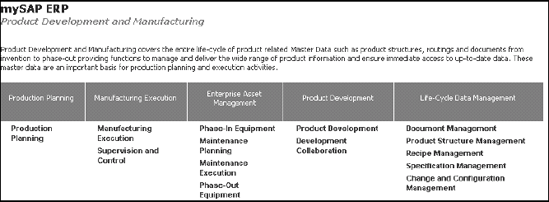
Figure 12-11. The current mySAP ERP Operations functionality in product development and manufacturing.
The long-term development in managing the life of your products will be driven by SAP's product lifecycle management (PLM) strategy, leading to improvements in two major areas:
Lifecycle Data Management: In this area, SAP will focus on enabling Enterprise Services Architecture for underlying product-related data, especially product structures. (A product structure is essentially all the details of what constitutes a product; it's a list of each individual element that is assembled to make the finished goods.) You'll be able to take advantage of the advanced product structure of the mySAP product lifecycle management (mySAP PLM) solution, which is known as the integrated product and process structure (IPPE). The result will be easier integration with partner and third-party applications.
Lifecycle Process Support: In this area, SAP will focus on creating an even deeper integration of mySAP PLM with the other applications of the mySAP Business Suite. For example, they'll integrate with mySAP SRM to improve strategic sourcing, and with mySAP SCM to create a combination of product and inventory collaboration scenarios. In addition, SAP plans to improve integration into CAD solutions, engineering change management, and manufacturing and design partner collaboration. Other areas for future improvement include the management of software used in products and configuration management for software and hardware.
The current sales and service functionality in mySAP ERP Sales and Service is outlined in Figure 12-12.
Future developments in the area of sales and service will focus on the use of business objects and core capabilities provided by the Business Process Platform. For example, new features could be used for telephony integration, to manage sales opportunities and service activities, and for broader applications of Internet pricing configuration (IPC). (IPC is a Web tool used to configure products; for example, think of how you can build a virtual car on a car manufacturer's site.)
mySAP ERP Corporate Services is your best friend when it comes to supporting administrative processes in the areas of quality management; environment, health, and safety; project portfolio management; real-estate management; and travel management. These are the types of processes that just about every business uses to keep its doors open for business. Improving efficiency in these areas can save everybody money. An overview of current mySAP ERP Corporate Services functionality can be found in Figure 12-13.
In the following sections, we present some of the changes coming to this area of ERP.
Portfolio management allows you to prioritize and align projects with your business strategy. In mySAP ERP, a combination of cProjects and SAP xApp Resource and Portfolio Management (SAP xRPM) allows you to set up a comprehensive project portfolio management system:
cProjects is a powerful and easy-to-use application that enables operational project management using a phase-based approach. cProjects focuses on resources and project roles, documents, and collaboration.
SAP xRPM delivers the foundation for strategic portfolio management by combining financial, strategic, and operational elements of the entire portfolio.
In 2005 and future releases, SAP's goal is the transformation to a service-enabled architecture that allows a more flexible user interface, deployment options, and a lower TCO. On a strategic level, there will be support for the portfolio lifecycle as well as scoring, simulation, and review tools to help you make decisions. In addition, SAP will continue to develop analytical features for all areas of project and portfolio management.
Plans beyond 2005 include
Ongoing integration between the strategic and operational layers of project and portfolio management.
Continuous improvements of resource management features and financial integration, especially for service industries.
Project and portfolio management will drive a successful New Product Development and Introduction (NPDI) process.
Developments are in the works to manage the product innovation process more efficiently and to establish a high transparency throughout the whole development cycle.
Extending the scope of project management to support the planning, execution, and reporting of Six Sigma projects.
As products and processes continuously change, so do the laws and rules that regulate them. Global businesses have gotten used to dealing with frequent changes in the number and complexity of environment, health, and safety regulations. These regulations have an impact on just about every area of your business, including purchasing, new product development, manufacturing, sales, distribution, service, and maintenance.
mySAP ERP provides capabilities for monitoring complex regulations, managing data and documents, tracking dangerous materials and products, carrying out waste disposal, enhancing employee and public safety, and supporting preventive healthcare.
Within the next three years, the developments in SAP Environment, Health, and Safety (SAP EH&S) will usher in SAP NetWeaver as the new technical platform, enhance the existing functionality to help you adapt to future legal requirements, and offer new processes to support customers to ensure compliance on a global scale. With the provision of the EH&S dangerous goods master data and the substance data on the ESA platform, customers can create and operate new business processes in line with essential EH&S information and ensure that they keep the compliance watchdogs happy.
Tip
In general, adapting to future legal requirements affects all areas of SAP EH&S. One of the major steps to come is the enablement of the technical and business aspects of the new European REACH. REACH stands for Registration, Evaluation, and Authorization of Chemicals. The EU will be using this new legislation to regulate the registration, evaluation, and authorization of chemical substances. Implementing REACH will involve substantial changes, in particular for companies producing or importing more than one ton of a chemicals per year. As a result, not only manufacturers but also importers and companies processing chemicals will have to rethink their processes.
SAP Travel Management supports all customers with a great end-to-end process for travel management. With SAP Travel Management, you can put into place a pretrip approval travel request; use a powerful online booking tool to book air, car, and rail travel and hotel reservations; and tap into a global expense management system.
In general, the SAP Travel Management system has seen a dramatic change in user-interface design. In the future, there will be additional UI elements, such as Universal Worklist Support, new entry scenarios for expenses, and further enhancements to the user interface based on customer feedback.
The trip request functionality supports, via the SAP Business Workflow tool, the complete process of pretrip approval, including requesting an advance, based on the new user-interface technology, which will be further enhanced to support Adobe Interactive Forms and SAP Internet service requests. In addition, the connection to the online booking system will be further developed, and the requirements of the public sector areas will be delivered in the form of funds management. Further enhancements are planned in the delivery of workflow templates for the trip request, which will deliver out-of-the-box standard workflow that fulfills many company requirements.
The travel planning functionality will be improved with generic standard interfaces to connect car and rail providers to SAP Travel Management based on SAP NetWeaver XI. In addition, further process improvements between the SAP Travel Management travel planning capabilities and travel agencies are in the works, including enhancements in workflow and lost-savings statistics.
In addition to the existing GDS interfaces (Sabre, Amadeus, and Galileo), there will be changes to the SAP NetWeaver XI interfaces, giving you a choice among more than 20 travel vendors for online booking.
The travel expenses functionality currently offers more than 20 country versions, and several new ones will be added, including Russia, China, Hungary, Brazil, and Australia. The credit card interface will be further enhanced to run through an SAP NetWeaver XI interface. In addition, SAP is developing full support of future credit card company data files, including hotel, air, and rental car portfolio data.
The travel expense management functionality includes a component for mobile applications called Mobile Time & Travel. The new version of Mobile Time & Travel will support a new user interface. In addition, more mobile scenarios will be supported by SAP, such as travel approval (planning, request, and expenses) by a manager via mobile devices, such as Blackberries and most PDAs. There will also be other mobile scenarios for Travel and Expense available, such as receipt entry via mobile devices or an overview of all open trips, including trip status. New Travel Planning scenarios will be delivered via mobile devices.
Analytics for SAP Travel Management will be enhanced to include reports and online graphics, such as the most-used hotels, lost savings, worldwide travel expense, and many more. You'll also be seeing templates based on Visual Composer that allow you to build company-specific dashboards. To deliver these reports, the interfaces for BW data to and from partners, such as credit card providers and booking systems, will be standardized via SAP NetWeaver XI interfaces.
SAP Real Estate Management supports customers by increasing transparency in their real estate portfolios, streamlining day-to-day business processes, and helping them make the right decisions.
Many country versions are currently supported. Future releases will provide additional country support, including more country-specific legal features for Japan, Russia, Portugal, and Spain.
